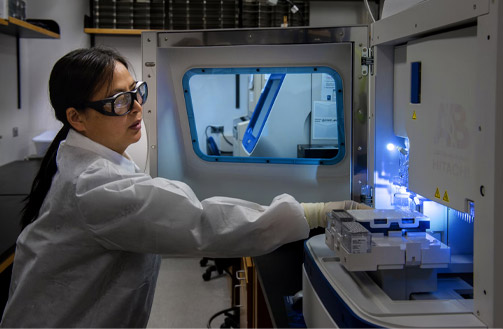
Blog
Biobot launches national wastewater monitoring project

June 3, 2021
Biobot was selected by the US Department of Health and Human Services, the parent department of the CDC, to execute a national COVID-19 wastewater monitoring project. We’re incredibly excited about this project, and we’ll be sharing stories about its progress in a series of posts, starting with this one.
Why we need wastewater-based monitoring now, more than ever
Now that about half of all Americans have received safe and highly effective vaccines against COVID-19, and with summer approaching, case rates are falling. This is great news, but it does not mean the pandemic is over. The virus that causes COVID-19 has spread over the entire world and continues to mutate. And while the virus may feel like a familiar threat, COVID-19 is still a very new disease. There are known unknowns, like which new variants will arise and what effect they will have on disease transmission and mortality. But we should also expect unknown unknowns as well. We should expect to be surprised again by this virus.
Throughout the pandemic, the primary tool for COVID-19 surveillance has been diagnostic tests, the nasal swabs that tell if a single person is infected with COVID-19 or not. However, testing “fatigue”, declining availability of tests, and limited support for those who do test positive mean that testing may become a less reliable public health tool as the pandemic continues. Furthermore, vaccine uptake remains uneven, and identifying the geographic boundaries of vaccine deserts using case counts alone will be challenging.
These conditions make wastewater-based COVID-19 monitoring, now more than ever, an important complement to diagnostic testing. For many people with COVID-19, the virus ends up in their stool, and so measuring levels of the virus in sewage gives a clue about how many of the people who contributed to that sewage have COVID-19. Wastewater monitoring has advantages and disadvantages relative to diagnostic testing, but, crucially, it is an independent measure of COVID-19 activity. This kind of useful redundancy is a way to protect against unknown unknowns.
Why we need a national wastewater monitoring project
It’s relatively easy to leverage wastewater-based monitoring at a hyper-local level. For example, Biobot provides COVID-19 monitoring for employers, universities, and for congregate living facilities, like jails and nursing homes. If the virus appears in the wastewater coming out of a building, someone in the building is likely infected, a facility-level leader can swiftly implement responses like quarantine or mass diagnostic testing. But more generally, wastewater monitoring provides situational awareness, a way to guard against the dynamics of COVID-19 activity that aren’t captured by diagnostic testing.
A national wastewater monitoring program has the same logic, to provide situational awareness and enable swift, data-driven responses. The data generated in this project will guide public health at multiple levels. First, the data will be delivered to the wastewater operators who generated the samples. In coordination with local public health departments and elected officials, they can use that data to inform local COVID-19 response strategies. Second, the data will be deposited in the CDC’s National Wastewater Surveillance System for use by state and local public health departments. Third, the data will go into the HHS Protect database, which the White House will use to inform how nationally-funded response resources will be distributed across the country.
In short, this project will provide elected officials and public health leaders, from the local level up to the White House and the CDC, with a representative, unbiased, nationwide picture of COVID-19 activity, all using a single set of harmonized protocols.
What else makes this project so exciting?
First, it’s the national scale. The project will include samples from more than 300 facilities, across all 50 US states and multiple US territories. In all, the program will cover almost a third of the entire US population.
Beyond simply having broad coverage, the project is also attentive to equitable coverage. It aims to provide services for communities where there is currently no state or local COVID-19 wastewater monitoring. Participating locations will include large cities as well as rural communities, from all socioeconomic strata, including Indian lands. Wastewater monitoring covers everyone who uses a community’s sewer system, regardless of their access to healthcare.
The project also includes support for genomic sequencing, which we expect will become an important tool in monitoring the emergence and spread of COVID-19 variants. Just as measuring levels of virus in wastewater is a complement to individual-based diagnostic testing, sequencing of virus genomes from wastewater could provide an efficient and comprehensive complement to the current approach of sequencing viral genomes from individual-level clinical samples. However, this kind of sequencing is a new approach, and implementing it at a national scale will surely lead to lessons learned. Stay tuned!
What happens next?
At Biobot, we believe that wastewater-based epidemiology will become part of our normal wastewater infrastructure. Wastewater treatment plants ensure our health and safety by making sure that water leaving the plant doesn’t pollute our lakes, rivers, or drinking water. We think it is only a matter of time until every treatment plant also monitors the water coming into the facility, ensuring our health and safety by giving public health officials information that can help prevent and mitigate epidemics. We see this project and ongoing Federal support for wastewater monitoring as an important step toward making the vision a reality.
How can I get involved?
- Wastewater operators: Read the CDC’s letter of support. Apply to join the program using this form.
- Elected officials and public health practitioners: Contact us if you’re interested in how wastewater monitoring can help your community. Connect with your local wastewater operators about joining the program. Stay tuned for data available from HHS Protect and NWSS.
- Scientists, especially epidemiologists and computational biologists: Contact us if you’re interested in a collaboration.
- Everyone: If you think this program is a good idea, tell your local public health department, your local elected officials, and your members of Congress!
Written by Scott Olesen, PhD
Scott is a computational epidemiologist at Biobot. Trained at MIT and Harvard, his specializations include infectious diseases, antibiotic resistance, and the microbiome.





